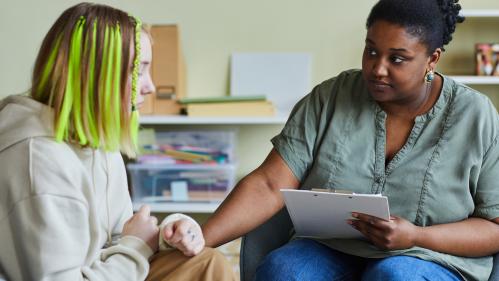How the Pandemic Impacted America’s Youth Mental Health Crisis

Joshua Langberg, a clinical psychologist, explains what must happen to ensure affordable, equitable care for young people
Even as the need for quality mental health care has climbed sharply among young people in recent years, access to services has gone in the other direction.
A 2019 study found that of the 7.7 million children and teens in the U.S. with at least one treatable mental health disorder, nearly half don’t get the care they require. The COVID-19 pandemic only exacerbated these trends.
Joshua M. Langberg, a licensed clinical psychologist and director of the Center for Youth Social Emotional Wellness (CYSEW) at the Rutgers Graduate School of Applied and Professional Psychology (GSAPP), is working to close this gap. He explains what drives the youth mental and behavioral health crisis, how the crisis manifests and what Rutgers is doing to ensure equitable access to mental and behavioral care in New Jersey.
COVID-19 lockdowns have been called “the largest psychological experiment ever conducted.” What did we learn from that experiment?
Youth and families, especially those from marginalized and low-resource backgrounds, rely heavily on their community – schools, religious organizations, pediatric health practices and friends and neighbors – for support. The pandemic took away many, even most of those connections.
Being virtual was fine for some kids and some families even preferred it. But if you relied on teachers, friends, school counselors and pediatricians for support and care, the combined stress and isolation associated with the pandemic likely led to mental health problems that were not identified and existing concerns that went untreated and increased in severity.
What issues are driving the youth mental and behavioral health crisis today?
COVID-19 did not create the youth mental health crisis in the United States. It exacerbated an existing crisis and laid bare the inequities and health disparities associated with mental health care in the U.S. and in New Jersey.
As an example, from 2000 to 2007, youth suicide rates were largely stable. From 2007 to 2019, however, suicide rates among young people ages 10 to 24 increased by 60 percent, according to the U.S. Centers for Disease Control and Prevention. These numbers continued to rise during the pandemic. We are also seeing massive mental health disparities, with some data suggesting that suicide rates for white youth declined while rates for Black youth significantly increased.
By comparison, rates of teen pregnancy, drug use and the likelihood of dying in an accident went down between 2007 and 2019.
That said, COVID-19 was associated with increased stress and social isolation for families, which happen to be two of the biggest drivers of mental health. We must take seriously the fact that many young people feel marginalized, and among those living in poverty there is often a lack of hope. When this happens, youth disconnect from their families and school and motivation to achieve drops. This leads to a vicious cycle where youth feel like they do not belong and are not being successful, which in turn leads to increased mental health concerns.
You’re an expert on attention-deficit/hyperactivity disorder (ADHD). Did COVID-19 exacerbate ADHD among young people?
Much of the attention on youth mental health has understandably been focused on depression and suicide. However, ADHD and anxiety are the most common mental health conditions affecting young people ages 3 to 17, with each affecting roughly one in 11 children.
We published data showing that the pandemic was particularly hard on families of adolescents with ADHD. The pandemic was associated with more difficulties concentrating, less structure and significantly reduced learning.
When we talk about mental health, it’s important to think beyond the moment, to think about trajectories. If our data show that families with ADHD really struggled during the pandemic, what does that suggest about their long-term academic and mental health outcomes? Two years of struggle is long enough to alter a child’s life-course trajectory.
Why is access to youth mental health care so uneven in the U.S.?
Accessing quality mental health care requires two crucial ingredients. The first is knowledge. To make the effort to find mental health care and overcome the stigma related to seeking care, people must understand what mental health concerns look like and that they are common. They must also know what type of service they need, or what type of service provider to call.
The second ingredient is access. People need a mental health provider that they can physically get to. But they also need a provider who has an appointment, has affordable rates or takes insurance and has the expertise related to the person’s concern.
Consider the situation in New Jersey, which has among the highest racial inequities in incarceration in the country. As a result, compared to white youth, Black children in New Jersey are far more likely to grow up in households with a parent who is incarcerated. Last year, 31 percent of Black youth lived in poverty compared to 11 percent of non-Hispanic white youth. Think about the implications of incarceration and poverty for families and schools and you begin to understand why access to mental health care is so uneven.
In addition to being a clinical psychologist, you’re also the director of the new Center for Youth Social Emotional Wellness at GSAPP. What’s the center’s mission?
The Center for Youth Social Emotional Wellness is part of the Rutgers Youth Behavioral Health Initiative and as director of CYSEW, I’m part of the leadership team. The Rutgers Youth Behavioral Health Initiative is designed to address the structural and systemic barriers we talked about earlier, to view mental health care holistically and to bring many different areas of expertise and perspectives to the table. As part of this overall initiative, the Brandt Behavioral Health and Treatment Center will dramatically increase access to high quality evidence-based mental health care.
Your center also has a strong training component, correct?
That’s right. CYSEW and the Brandt Center will partner to train the next generation of mental health providers, with a focus on rapidly increasing the number of providers trained in evidence-based mental health working in community and school settings
CYSEW and the Brandt Center will also collaborate to ensure that all mental health training programs at Rutgers understand the systemic and structural issues that drive mental health disparities. We will provide cross-disciplinary training opportunities and host meetings where each profession can learn from the other. We will bring researchers together to develop new and innovative ways of addressing mental health.
Rutgers views the Youth Behavioral Health Initiative as a national model of adolescent and young adult behavioral care. How so?
Because the initiative addresses all the core components that make up our system of mental health care, from education and prevention to treatment and evidence-based training. Also, because the initiative is community driven. What one community needs and the barriers they face can be completely different from what another community needs. We must stop assuming and start listening.



